The Dell EMC PowerEdge T40 is a cheap server. It sacrifices many of the hallmark features of the PowerEdge line in order to achieve an extremely low cost. Since it is designed to be a starting server for the SMB, SOHO, and edge computing space, the trade-offs mean that Dell can compete aggressively on price. Although at the time of writing this review it is $669 on Dell’s website, they can go into the $349 range when promotions are available and applied. For some sense of how inexpensive the rest of the system is, the list price for the Intel Xeon E-2224G is $213 (tray price, excluding incentives and OEM discounts.) If this is the class of server you need, then it can be an extreme value. In our review, we are going to look at the great features, the trade-offs made to hit this price, and some of the adjacent options and competition in this space.
Dell EMC PowerEdge T40 Video
If you want to listen to a review rather than read, you can check the accompanying video.
We have more detail in the review here but there is a bit more color on the video version.
Dell EMC PowerEdge T40 Overview
The Dell EMC PowerEdge T40 is a 20.4L chassis which is about 25% smaller than the previous-generation PowerEdge T30 which was 27.4L in size. This chassis may look familiar to some. It seems to be shared between the PowerEdge T40 and the Dell Precision 3630.
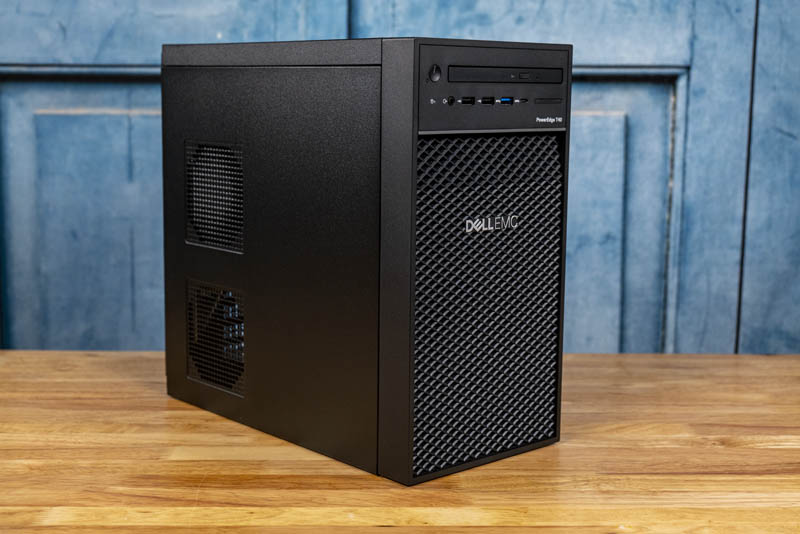
Looking at the front of the system, we see some unique features. Since this is a server, based on a workstation platform, we get a front audio jack, four USB ports including a USB 3.0 and Type-C port on the front of the system. We also get an optical drive bay that uses a DVD RW drive. This is also in the workstation version, but it seems like removing the DVD drive could be a way to save costs. External units sell for $15-20 new (see Amazon.)
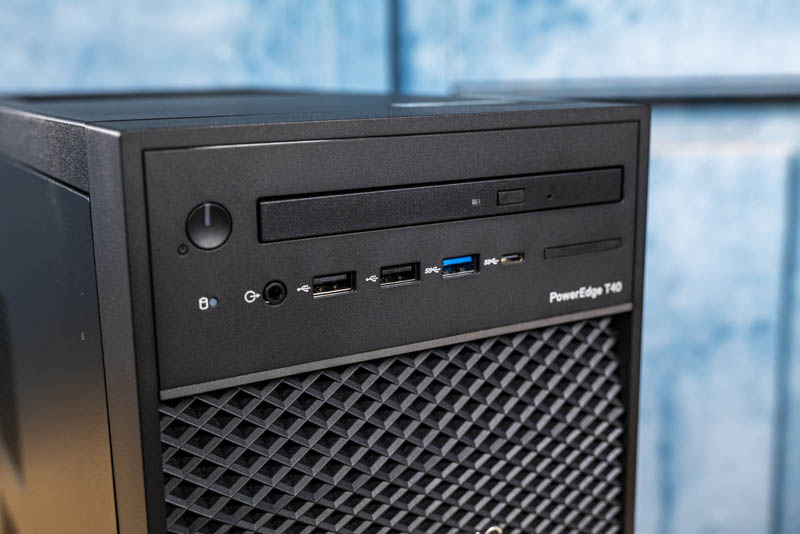
Looking at the rear of the system, we have a fairly standard workstation layout as well. We get serial console and PS/2 mouse/ keyboard ports. There are four USB 3 and two USB 2 ports. One gets a single 1GbE port with an Intel i219 controller. That is important for OS compatibility and is likely a reason we do not see VMware advertised on the T40’s product page. Another unique feature is that we get two DisplayPort outputs. Although this is a server, it can drive dual 4K displays without issue.
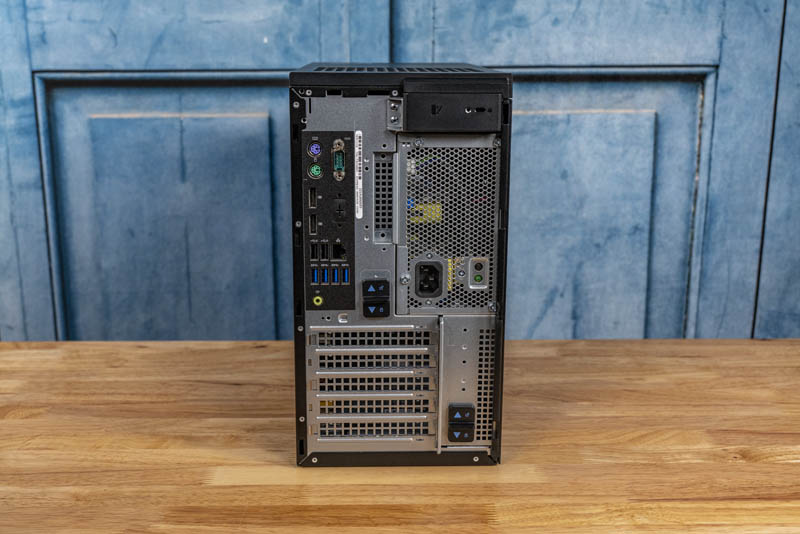
A nice feature one does not get on many other servers in this class is some of Dell’s mechanical design. As an example, to open the chassis, instead of screws, one gets a nice latching mechanism that releases the side cover.
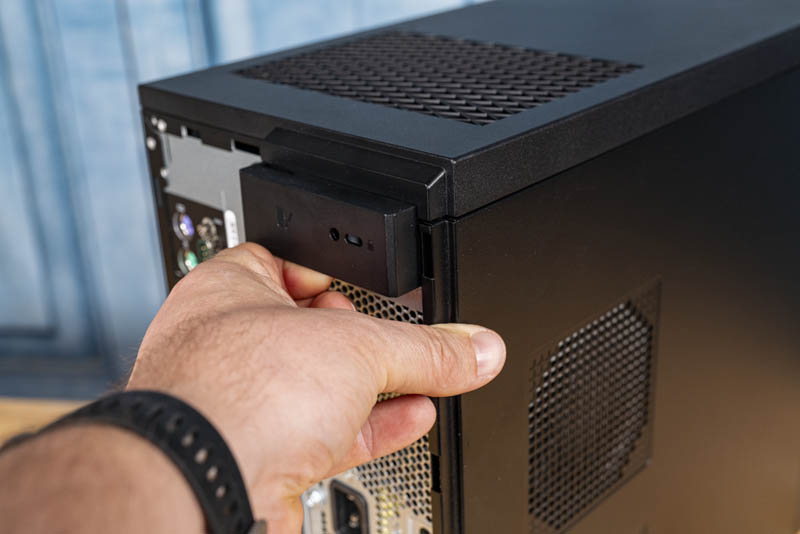
Another nice feature is the Service Information guide. This is an important feature since it helps those servicing the system understand some layout and procedural nuances. If one thinks of a SMB server that is deployed and must be serviced in 5 years by a non-technical employee that is exactly the scenario that these guides help with. Many other competitive servers skip this type of feature, especially in the white box or build-your-own segments of this market.
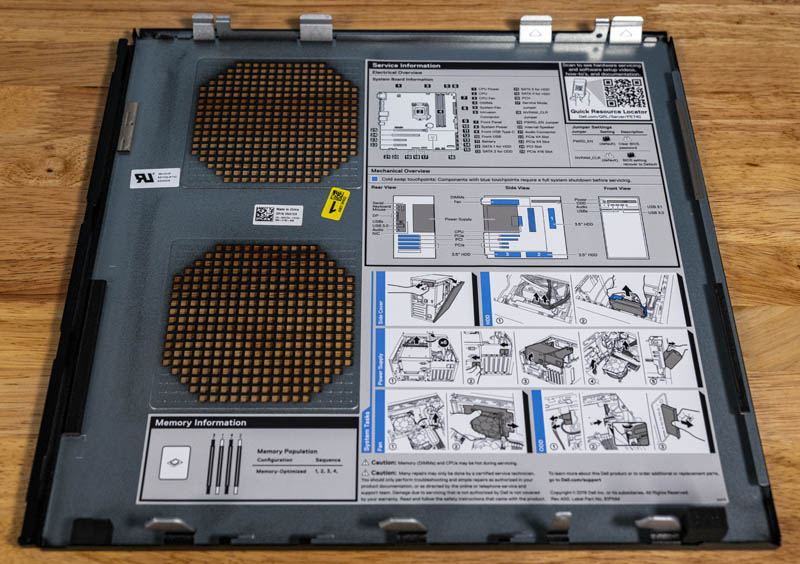
Once the cover is off, one can see how Dell managed to keep the PowerEdge T40 so compact. Although it is a traditional mini tower form factor, Dell places the PSU above the CPU area to optimize volumetric utilization.
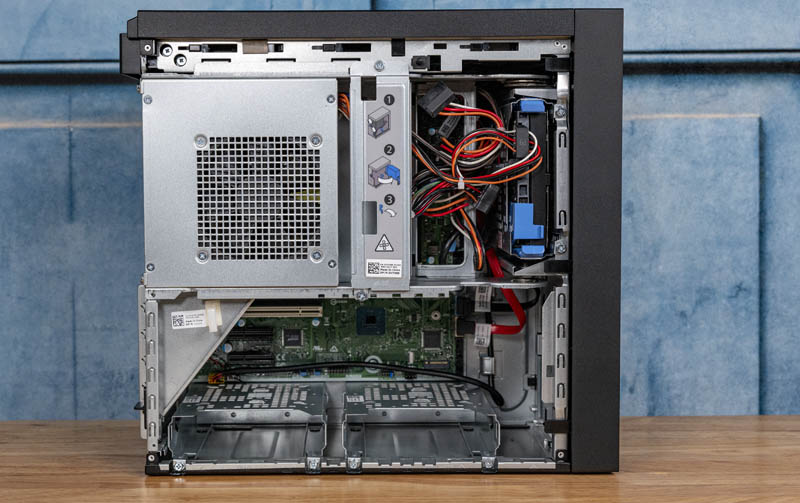
An awesome feature of this chassis is the swing-out PSU. One can de-latch the PSU arm from the rear then swing the PSU out of the way. this gives easy access to the motherboard. Cables are oriented such that they remain attached even as the PSU moves on this swing arm. The PSU is a 300W 80Plus Bronze unit. In comparison, the Precision 3630 uses a 300W 80Plus Gold PSU. This is part of the theme of the PowerEdge T40 trading eco-friendliness for lower costs.
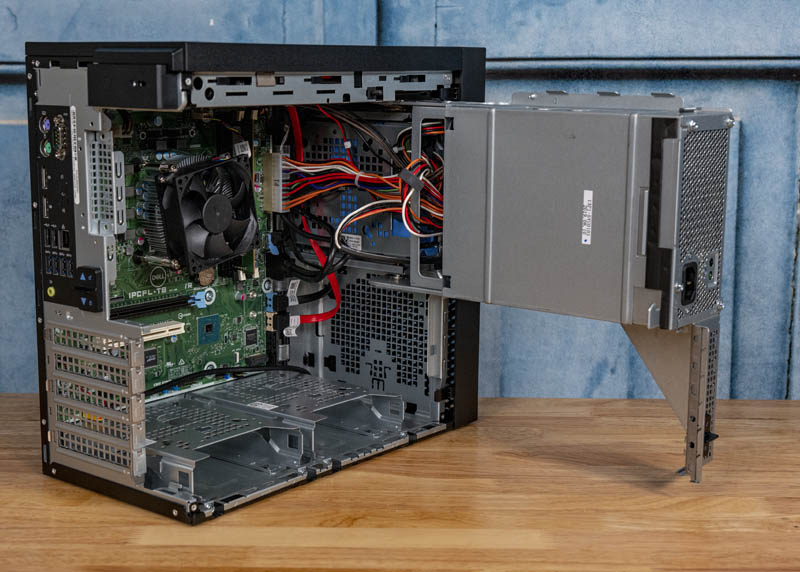
Looking at the motherboard, we can see a fairly standard layout.
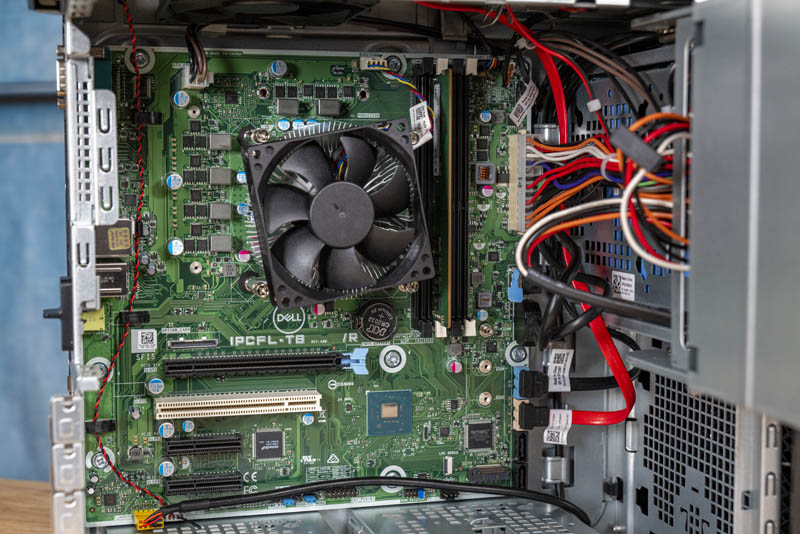
The CPU uses an LGA1151 socket. In this case, we have an Intel C246 chipset platform and the pre-configured CPU is usually the Intel Xeon E-2224G. We should note that the Intel C246 has features that are not being utilized here. For example, we get AMT 12 support, but not vPro support. vPro support would have been excellent for a lower-cost IPMI alternative. We also get 8GB of memory installed. The system can take up to 4x 16GB for 64GB of memory. Intel supports up to 4x 32GB or 128GB with this CPU and PCH, so this is another example of not utilizing the entire platform’s features to save costs.
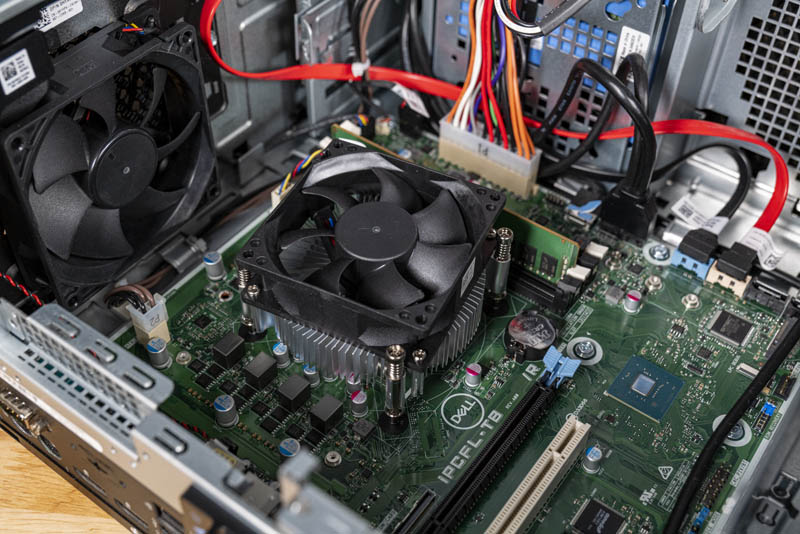
The 1TB 7.2K rpm hard drive is affixed to the front side of the chassis, between the PSU swing arm joints. Hard drive installation uses a blue plastic carrier that is extremely easy to service. We will note that this is not a hot-swap backplane solution and each drive is individually cabled.
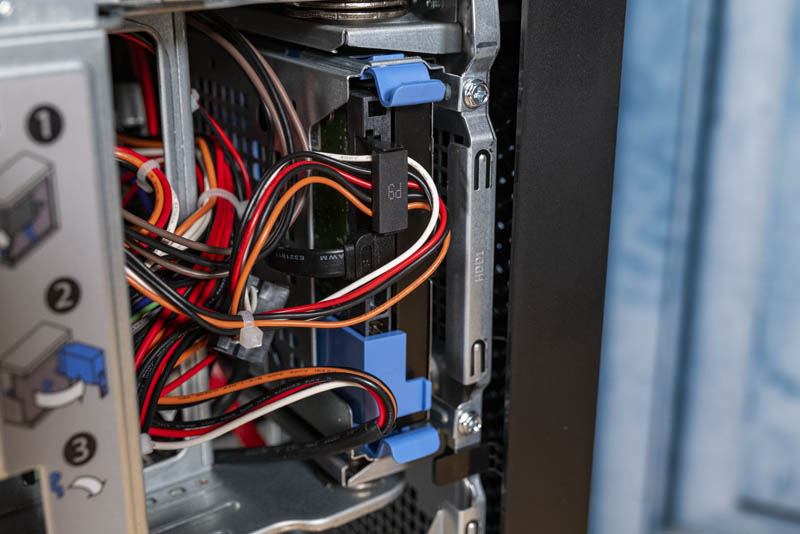
Perhaps the biggest fault we have with the system is not providing two additional blue carriers for additional hard drives. There are spaces for up to three 3.5″ drives, but Dell does not include the carriers. While this is more common at the higher-end of the segment, for the SMB/ SOHO space these should be included with the system to make installation easier. Some markets that will get the PowerEdge T40 may not have the best access to official Dell drives for this system. We would gladly trade the optical drive for these trays. From a competitive standpoint, the HPE ProLiant MicroServer Gen10 Plus has four drive bays (also not hot-swap) and includes mounting hardware for all four.
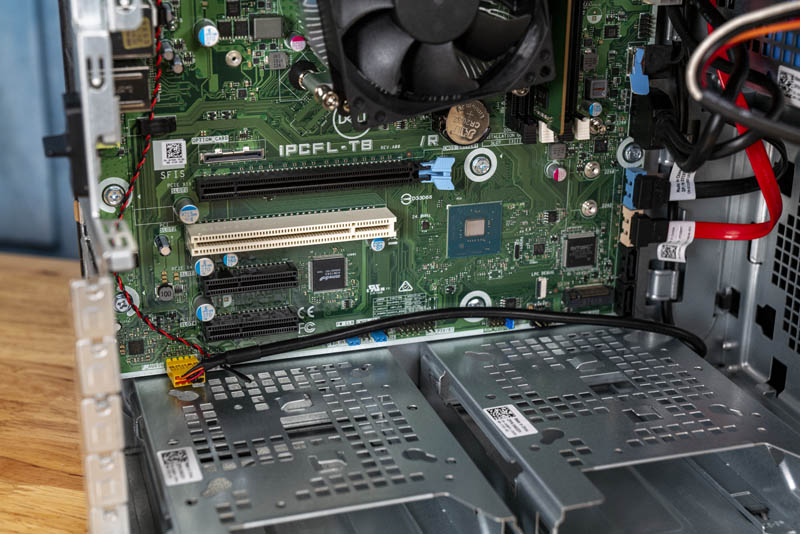
On the subject of expansion, one can see that there is a PCIe Gen3 x16 slot, two x4 slots. There is also a legacy PCI slot. PCI was developed in the early 1990’s, it was prominent until around 2004-2006 as PCIe became the new standard. This is effectively a slot that is two decades past its prime. One will say there are still solutions that require PCI, but at this point, the number of systems being produced with unused PCI slots makes this largely superfluous and not very eco-friendly. We can save some plastic and energy by not putting these in all but extremely specialized systems.
We will note that there is an M.2 slot. While this functions on the Precision 3630, we could not get a drive recognized on the unit we purchased in this slot.
One may have noticed we did not mention iDRAC. To save costs, the iDRAC BMC solution is not included on the PowerEdge T40. That means one has AMT like a desktop, but not a server-like BMC. HPE removed the feature on the HPE ProLiant MicroServer Gen10. As we saw with our HPE ProLiant MicroServer Gen10 Plus v Gen10 Hardware Overview and subsequent MicroServer Gen10 Plus review, HPE received feedback that its customers wanted to manage servers at the edge as they would servers in the data center. One will need to step up to the Dell EMC PowerEdge T140 for that feature. Without iDRAC, it starts to become debatable whether this is a server or a workstation.
Next, we are going to look at our test configuration and performance before getting to power consumption and our final words.

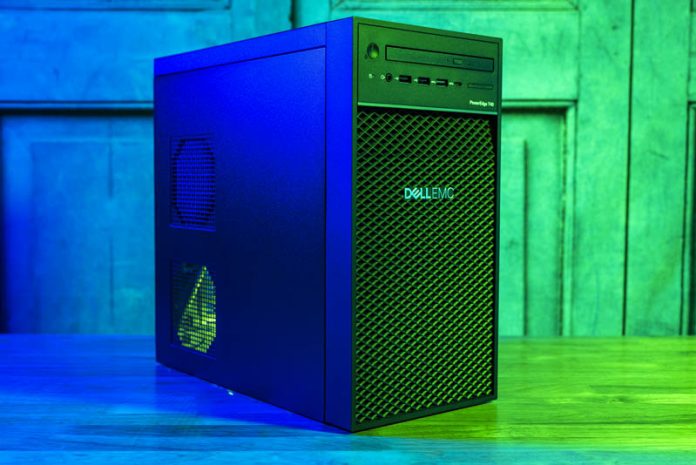



Hi Patric, love the article. One thing I need to point out. Yout T40 lower two hard drive mounts don’t use a blue sled type mount. Only the vertical 3.5inch mount uses a plastic insert.
I know this because my main system is a (late 2017 or ealy 2018) Dell XPS 8930 and it has the same chassis (as far as I can tell) as the T40. My XPS came with a hard drive in the bottom bay closer to the front. The hard drive screws into the metal cage with the old school style 4 screws from the sides of the HDD cage. You are able to reach these screws by taking out a drive cage by undoing the two screws holding each of the two cages to the larger case.
I double checked this was the case before posting this. As far as I can tell the metal parts are the same. Though oddly my unit came with SATA power routed to all three bays. The bottom two are fed by one power cord from the PSU. Email me if you want me to shoot over a photo. Also on page 16 (irl pg 31 on the pdf) of the Dell 8930 service manual it talks about the drive bays.
You forgot to include power figures. What’s the actual idle power consumption? What’s the actual MAX power draw? 6W lower is not helpful
In my opinion there are no servers without ECC memory. This is by far the cheapest option with ECC support and support for VMware ESXi. What a value!
I don’t think too many people will be trying to run VMware ESXi on a 4C/4T CPU on a machine with 64GB or less of RAM.
I definitely see the utility of a machine in this price category for Edge, SOHO, and SMB usage.
This looks exactly like the case of an Alienware Aurora R17 minus the AIO cooler and the flashy extra plastic bits.
Could you please further detail what it means that the T40 has AMT but not vPro? AMT by itself should be enough for out-of-band management, correct? What elements of vPro are missing, and does their absence somehow make OOB management impossible? Thanks.
As a “long-time” owner of a $400 T30, which uses a case similar to the Optiplex 980, I can say these machines are a mixed blessing. The motherboard and PSU on the T30 are BTX not ATX. You are looking at no possible upgrade path. The T30 is better equipped with 2x 3.5″ bays (blue sleds included, which can break/snap), 2x 5.25″ open bays and 2x 2.5″ spaces (not found on the Optiplex) after removing the DVD. However, I run it without side panel due to inadequate air circulation. They fit on their side on a rack shelf. This T40 looks much more crapped and have even less air circulation (holes cut in the side notwithstanding). The PCI slot is useful on the Optiplex 980 for GPU to regain use of both PCIe slots. A very old, used PCI NIC might find use in the Tnn boxes as they have working graphics without a dedicated slot. With a RAM upgrade and packed with drives, they can have some use running double duty with two guests on ESXi. Though upgrading a $400 box with no future is futility at best.
Engaging article I found, at the same time of looking to buy a workstation server with Xeon processor, for my home virtualization learning lab.
What time of the year should I expect a promotion from Dell on the PowerEdge T40?
Also, readers of this article, do you recommend I buy a brand NEW workstation server with medium specifications of a USED workstation server with higher specifications (for a home virtualization learning lab)?
Thanks
@Salama A. Dell has a July sales promotion every year and may have another in the winter (?). They also sell refurbished gear as available and have discounts/promotions on select items from time to time.
Regarding new vs used, a good part of the decision is your comfort level. Warranties and service are less available (or not), depending on source. You may find some better specs (e.g., memory or storage), but last years model will not have the latest CPUs and such.
I confused the T30 with the Optiplex drive bays. The T30 has 4x 3.5″ blue sleds (with 2x 2.5″ tucked away at top), and the Optiplex has 2x 3.5″ and 2x 5.25″ bays.
Another issue with these models is limited power supply connections. No GPU power (and unlikely the space for full-length cards) and only sufficient molex power for the supported drive configuration: no spares for extra fans. As the PSU is BTX, you need to botch an ATX PSU to replace it. Available SATA ports are limited to four on the T30 without an additional HBA card.
Also don’t forget: Dell disabled the M.2 slot which it inherited from the Precision workstations motherboard base. That takes away basically a full PCI3.0x4 slot from the already low amount of PCIe lanes of the small Xeons.
They did this as well in the T30 BIOS after version 1.02, but before it was useable.
In addition, the option for enthusiasts to throw in higher clocked/more core count CPUs seems not all to reasonable as cooling and airflow are limited. In the web, there are reports of noisy “Precision”-siblings with stronger CPUs…. and we know how much heat that CPU platform can generate under loading.
So, technically and value-for-money wise, the T40 is not very attractive to enthusiats like it was the case with the T20/T30.
I few very negative on this chassis which was reused among many Dell products (XPS, Alienware Aurora, etc…).
The major flaw is the poor CPU thermal dissipation. The CPU fan is block by the PSU. Meanwhile, the front HDD blocks the air flow from another angle.
A second flaw is lacking of HDD bays. It is OK for office or gaming machine, but not accepable for server.
Is VMware ESXi supported on the T40?
Which is good server for virtualization –
Dell PowerEdge T40
and
HP ProLiant ML10 v2
I have the same questions as Christos So and Nitish Jamudiya. Can some one share their experience when running ESXi on these server?
ESXi 7 running like gem, without any issues. I have the e-2224G + 64Gb non-ECC RAM from Crucial. I have a 2 node vSphere cluster driven by 2 Dell T40 with the same configuration.